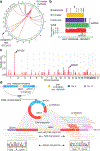Extrachromosomal circular DNA drives oncogenic genome remodeling in neuroblastoma
- PMID: 31844324
- PMCID: PMC7008131
- DOI: 10.1038/s41588-019-0547-z
Extrachromosomal circular DNA drives oncogenic genome remodeling in neuroblastoma
Erratum in
-
Publisher Correction: Extrachromosomal circular DNA drives oncogenic genome remodeling in neuroblastoma.Nat Genet. 2020 Apr;52(4):464. doi: 10.1038/s41588-020-0598-1. Nat Genet. 2020. PMID: 32107479
Abstract
Extrachromosomal circularization of DNA is an important genomic feature in cancer. However, the structure, composition and genome-wide frequency of extrachromosomal circular DNA have not yet been profiled extensively. Here, we combine genomic and transcriptomic approaches to describe the landscape of extrachromosomal circular DNA in neuroblastoma, a tumor arising in childhood from primitive cells of the sympathetic nervous system. Our analysis identifies and characterizes a wide catalog of somatically acquired and undescribed extrachromosomal circular DNAs. Moreover, we find that extrachromosomal circular DNAs are an unanticipated major source of somatic rearrangements, contributing to oncogenic remodeling through chimeric circularization and reintegration of circular DNA into the linear genome. Cancer-causing lesions can emerge out of circle-derived rearrangements and are associated with adverse clinical outcome. It is highly probable that circle-derived rearrangements represent an ongoing mutagenic process. Thus, extrachromosomal circular DNAs represent a multihit mutagenic process, with important functional and clinical implications for the origins of genomic remodeling in cancer.
Figures




References
Publication types
MeSH terms
Substances
Grants and funding
LinkOut - more resources
Full Text Sources
Other Literature Sources
Medical

